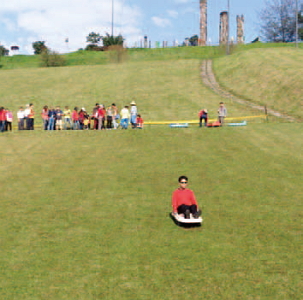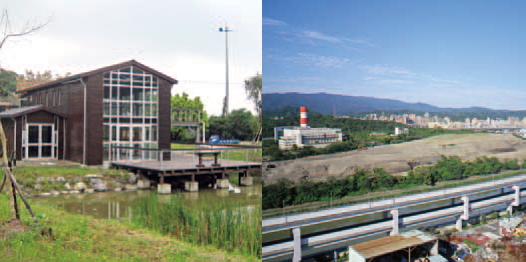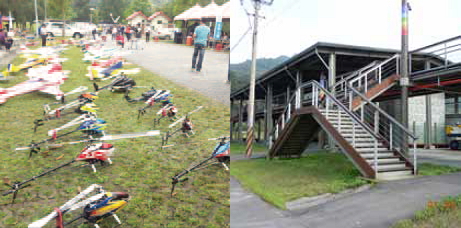From Landfill to Green Parkland
Fudekeng Eco-Park Fudekeng Eco-Park (福德坑環保復育園區) is in the Wenshan District (文山區), on what was originally the Fudekeng Sanitary Landfill Site (福德坑垃圾衛生掩埋場). The landfill was filled and closed down in 1996, and green remediation work started. This was the country’s first such project, serving as a model for others. The eco-park’s attractions are varied, among them trails, rest pavilions, over 3,000 trees of various species, grass skiing and remote-control aircraft flying areas, and an indigenous park area. Located on a height, the views are expansive. Grass ski carts are available for free at the wide, sloping ski area. The remote-control aircraft area, an open secret among local enthusiasts, is at the park’s highest point. On weekends and holidays, it fills up with people testing out their skills on an impressive variety of planes. This facility is, in fact, Taipei’s only legally authorized remote-control aircraft flying field. Located in the southeast corner of Nangang District (南港區) in the border area with New Taipei City’s Shenkeng District (新北市深坑區), Shanshuilu Ecological Park (山水綠生態公園) is on what was originally the Shanzhuku Sanitary Landfill Site (山豬窟垃圾衛生掩埋 場), Taipei’s second large-scale sanitary landfill site. Remediation was started in 2003, and a formal request for a change to the present name was submitted and granted in 2011. This spot was long ago named Shanzhuku, which literally means “wild boar hole,” because wild boar would gather at a local drinking hole. The new name, which contains the characters for “mountain,” “water,” and “green,” signifies the return of abundant flora and fauna following remediation. The site’s pretty landscaping includes a forest-hut cafe, flower slope, and tung trees. Expected to open in August, this will be a fine spot for a green escape. Located beside the winding Keelung River, the landfill beside the NEI-HU Refuse Incineration Plant (內 湖垃圾焚化廠) was left covered over and unused for 20 years before remediation work was begun in 2006. The anticipated completion date for the work is the end of this year. A public naming contest will be held down the road, stimulating interest in the park and the site’s new lease on life. An eco-sensitive approach was taken to cleaning up Neihu’s mountain of unincinerated garbage. Instead of just hauling the garbage to another site, it was screened, classified, and underwent another round of recycling. The refuse left over was then incinerated, and the site backfilled with soil, assisting recovery. When work on the riverside park is completed there will be a 40-meter-high terraced viewing platform and 20,000 trees will have been planted. From the top of the Landfills and parks have diametrically opposed images, yet by fusing eco-protection and leisure/ recreation concepts, landfills around the world are being restored and transformed into green spaces. The Taipei City Government is an active participant in this movement, to date creating three new “green lungs” that have become popular destinations with citizens seeking green-spaces in the city.
Landfills and parks have diametrically opposed images, yet by fusing eco-protection and leisure/ recreation concepts, landfills around the world are being restored and transformed into green spaces. The Taipei City Government is an active participant in this movement, to date creating three new “green lungs” that have become popular destinations with citizens seeking green-spaces in the city. Shanshuilu Ecological Park
Shanshuilu Ecological Park Neihu Waterside Park
Neihu Waterside Park
lookout visitors will have a bird’s-eye view of the Keelung River and riverside bike paths in the foreground and of the soaring Taipei 101 in the distance. The park will be a proud new landmark showcasing the city’s embrace of green consciousness.

![Taiwan.gov.tw [ open a new window]](/images/egov.png)
